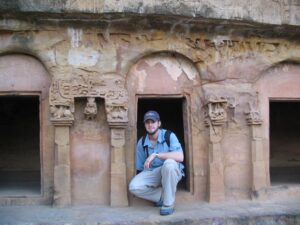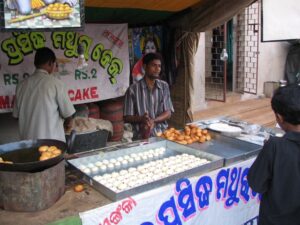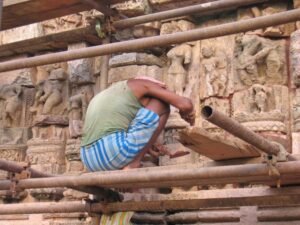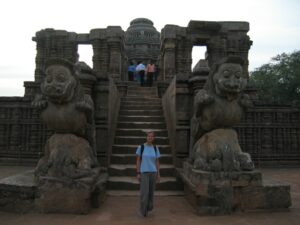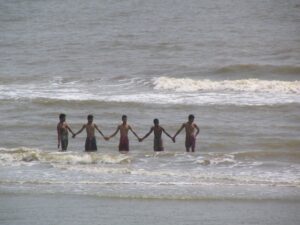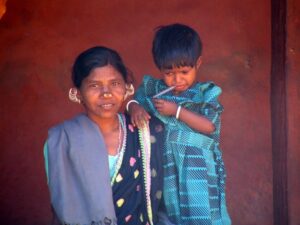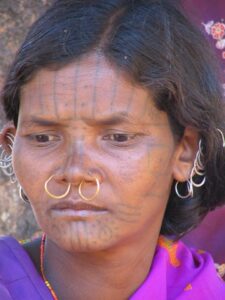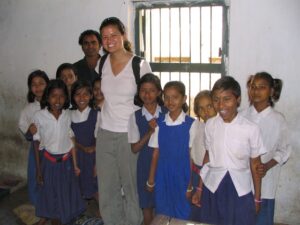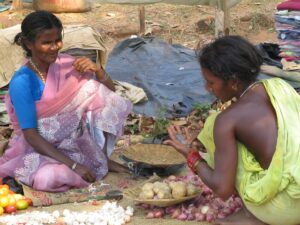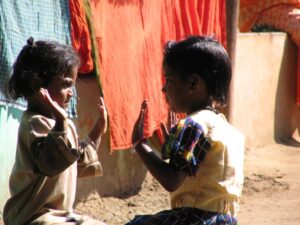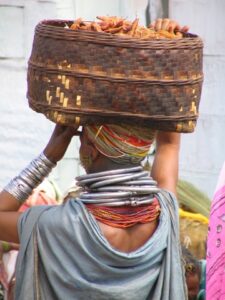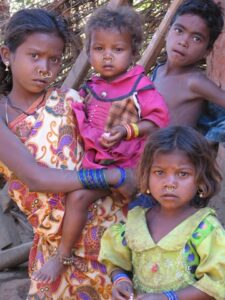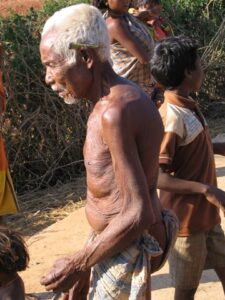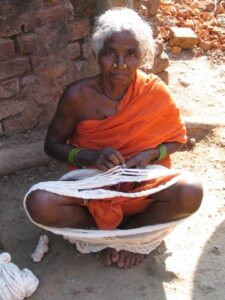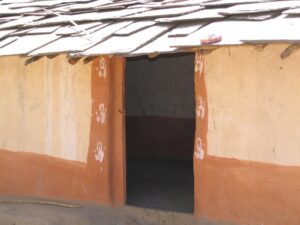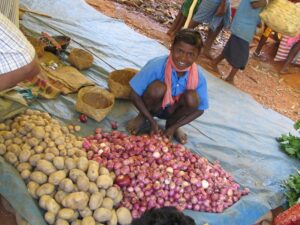We have seen tours of India that last over 4 months but still leave a lot undiscovered. India is a vast and diverse country! We loved our first trip to India where we embarked on a Golden Triangle tour, but for our second trip here, we wanted to do something different. We settled on the Orissa region of India, where an amazing 62 tribal communities exist in harmony. The Indians refer to the tribal groups as “adivasis”, which literally means “original inhabitants”. We didn’t have a specific agenda but did want to witness tribal customs, rituals and beliefs, as well as the colorful weekly markets where entire communities converge in a spectacular affair.
Becky contacted several travel agents and finally settled on Indian Tribal Tours (Mr. Aftab Baktoo, email: info@ittmails.com or www.india-tour.com) who created a custom 12 day itinerary that hit all the major highlights of Orissa. He was able to cater a budget priced, all inclusive tour for a bargain so we were quite happy to do business with him. Afghanistan’s national airline, Ariana airways, flies biweekly flights from Kabul to Delhi so getting there was the easy part. Highlights of our Orissa tribal tour included a visit to Konark’s sun temple, Puri’s Jagannath temple, Baliguda’s tribal villages, Kutia Kondh tribes and weekly market, Dongariya’s weekly market, Bondas’ tribal weekly market, Gadhaba tribal villages, Dhuruba tribal villages, Marias’ Mardoom Saturday market, and Narayanpur’s Sunday market.
Lonely Planet India provided very limited information on Orissa’s tribes so we did a bit of research independently and found out that the tribes of India are fascinating. Here is a bit of the background that we discovered:
• Orissa has 62 tribes
• Most tribes retain their traditions despite the onslaught of modern civilization encroaching upon their turf
• Tribes inhabit Orissa’s deep forests and hilly interiors
• Anthropologists/sociologists are fascinated by the Orissan tribes numerous customs, beliefs, and practices. Little is truly known about these tribes
• Farming, hunting and fishing are the tribes’ main sources of livelihood
Day 01: February 18, 2005 ( Friday) Arrive New Delhi
What a long day! We decided to wake up at 0400 to do laundry and pack our bags (procrastination is a very dirty word). Ariana airlines had informed us that our flight would be delayed for 6 hours, so we decided to put in a half day of work. The skies were cloudy and overcast, prompting Becky to fret that our flight would be cancelled. (Ariana has been extremely cautious about flights ever since the Kam air crash on 4 FEB) Miraculously, our prayers paid off and the skies erupted in a brilliant display of blue. The light snow that had been falling immediately dissipated and we knew we would get out of Kabul. Our friends Ray and Edwin dropped us off at KIA (Kabul International Airport). What an interesting drive to the airport. They solemnly told us it was one of Kabul’s most heavily mined, which kept us all on our guard. You can imagine our unease when we were abruptly halted and could go no further due to a VIP entourage that was arriving. We later found out that the reason for our 6 hour delay was the reception of the VIPs…sure wish we knew who they were!
KIA is a zoo. We were dropped off and pointed in the right direction. However, it was absolute mayhem inside the airport, with everyone excitedly jabbering and pushing their way into some sort of a queue to check in for the three flights that day (Istanbul, Tehran, and Delhi). We joined in the throng of pushing, confused people and soon befriended some young men traveling to Tehran. They tried out their Pidgin English with us and we were able to cut in line in front of them. Checking in was pretty easy but we were absolutely bewildered when it came to our luggage. There was no coherent system in place. A gruff old man grabbed Robby’s bag, threw it on the floor and pushed him ahead. Robby got indignant and grabbed his “check in” bag after deciding not to chance it with KIA’s staff. We passed through passport control with no issues and soon found ourselves in a smoky, freezing waiting area where all three flights’ worth of passengers were herded in like animals. Half the room was standing area only and we were lucky to have arrived early for a seat. Distributions of candy to our neighboring passengers were well received, with the men placing their hands over their heart, in a symbol of thanks. We love that gesture…it is one of the best that we have seen in Afghanistan.
The flight starting boarding at 1610 and an amazing 20 minutes later, all of us were in our seats and ready for take off. The Afghans do not joke around when it comes to boarding a plane. Its virtually first come, first serve as our seat assignments were very fluid (we grabbed the seats of our fancy after noticing that ours were already taken). This practice is sanctioned by the Ariana staff, who realize that we will take off on time if folks can duke out their own seat assignments. We took off with little fanfare and marveled at the snow-covered mountains surrounding Kabul. It is a beautiful sight to behold from the sky. Dinner was served and what an interesting concoction! We had a chicken leg and potatoes wrapped in flat bread, along with a side of orange. If this doesn’t appeal to you, bring your own snacks. As for us, we were ravenous, so we tore the chicken apart just like our fellow passengers. It was really funny to experience the smell of chicken and orange drifting through the aisle.
Our arrival to New Delhi International airport was a short 90 minutes later, and we rushed through passport control with no issues. We were able to obtain an amazing 10 year multiple entry visa, which will enable us to visit India many more times hassle free. Our guide was waiting to receive us at the arrival lounge, but he was a bit flustered. Apparently, Becky’s email that our flight was to be delayed did not reach him, and he had been diligently waiting for us since 1400 that afternoon (we were only 7 hours late!) He briefly whisked us off to our awaiting transport and informed us that link up time tomorrow was a 0900 for our onward flight to Bhubaneswar. Our driver wound in and out of insane Delhi traffic to bring us to The Connaught (conveniently located next to Shivaji Stadium on 37 Shaheed Bhagat Singh Marg, New Delhi). Ironically, we stayed at this same exact hotel just over a year ago, on our first trip to India! We realized it as soon as we entered the hotel foyer and recognized the Hindu-style art décor. We instantly crashed after our long day and were excited to experience more of this fabulous country.
Day 2 February 19, 2005 (Saturday) NEW DELHI / BHUBANESWAR
After grabbing a delicious breakfast buffet at The Connaught, we checked out and linked back up with our guide. He took us directly to the Indian Tribal Tours office, where we were able to make a credit card payment for the tour and pick up our flight tickets. We were escorted to our car, which competed with Delhi traffic to bring us to the Delhi domestic airport. We are still amazed with traffic in India. Anything goes and you can typically see bicycles, tractors, rickshaws, tuk-tuks, lorries, tricycles, SUVs and mini-cars all zoom in an out of each other’s lanes in a methodical madness. Upon arrival at the domestic airport, we checked in at the Indian airways counter for our flight to Bhubaneswar. After breezing through all the check in procedures, we waited for our flight in the very clean and comfortable lounge. There were several Indian airways flights departing from Delhi at the same time so we had to pay attention to our flight’s announcement. Service on India airways is great and we were treated to a lunch of Chicken curry (of course!).
Bhubaneswar is just under 2 hours from Delhi and we arrived to a steamy 33 degrees Celsius temperature. We were met by Arati, Saroj, and Brasanda who were our travel coordinator, guide and driver, respectively. Arati placed orange flowered leis around our necks and informed us that it was a traditional Orissa greeting for newcomers. We were taken directly to Bhubaneswar’s most ritzy resort, the Mayfair Lagoon hotel. The Mayfair is a 5 star joint, and an unexpected surprise, considering that we requested to go as budget as possible! We were later to find out that the grungy lodges at remote villages would more than compensate for the initial posh accommodations. Blissfully ignorant, we marveled at our room’s spacious interior, marble floors, lakeside view and tasteful décor. The entire Mayfair hotel was decorated in old colonial style, with wide open columns, open courtyards, antiques galore and massive rooms. Whoever owns the Mayfair chain has impeccable taste, as the four Mayfair hotels are listed as heritage hotels.
At 1500 sharp, we began our half day’s itinerary with Saroj and Brasanda. First stop was the King and Queen’s temple, better known as Rajarani temple. It is famous for its ornate temple sanctuary and tower, and reminded us of the temples of Angkor. The amazing thing is India is full of similar temples, yet does not pull in the same numbers of tourists that Siam Reap does. Rajarani was built in circa 1100 by the Lion dynasty, who came into power after the elephant dynasty (hence all the lions are built atop elephants on the temple’s walls). We later read that the lion is a symbol for Hinduism, and the elephant represents Buddhism, which explains why lions riding elephants is such a popular Orissa temple theme. Carved within the temple walls were depictions of nymphs, embracing couples, and animals. Saroj pointed out the “lazy girl” pose, which portrays a female with crossed legs and raised arms. She is referred to as “lazy” since in that position, she provides for entertainment value only and conducts no work. We really enjoyed the carvings of Rajarani, which set the tone for the other temples we were about to visit.
Our next stop was a brief one beside the Bindu Sagar (a lake that is also known as the Ocean drop tank). Saroj explained that it is said to contain water from every holy stream, pond, and tank in India and it was full of family members dipping in to cleanse away their sins. We had a fine view of the Lingaraj Mandir, which is an enormous 54 meter high temple that is closed to non-Hindus. Next was a lengthy stop at the temple complex of Mukteswar, Siddheswar, and Kedargauri Mandirs. (Mandir stands for temple, all of which are guarded by temple custodians who demand a “donation” for the upkeep of the grounds. Don’t be swayed by their strong arm tactics…they will attempt to extort 100 Rupees per person but a fair amount is more like 40) We really liked the intricate Torana arch in front of the Mukteswar temple. The temples here are some of Orissa’s most ornate, all of which show a blend of Buddhist, Jain, and Hindu style.
We took a small excursion 6 KM outside of Bhubaneswar towards the Udaigiri and Khandagiri cave complex. We were in luck to coincide our trip with the third annual Kharavela festival that was going on at Udaigiri/Khandagiri. The street was packed with happy revelers and we bypassed the festivities to check out the cave complex. We spent most of our time exploring Udaigiri (Sunrise hill). First stop was the Queen’s Palace Cave (Rani Ka Naur), which showed some battle scenes. The coolest thing here was a room that is connected to another room via a hidden ceiling passage…be sure to duck as you crawl into the rooms since they are built very low to the ground. The other caves are worth checking out, with one of the most unique being the Bagh Gumpha cave (tiger cave), with the entrance the mouth of the tiger. Monkeys populate all of the caves, so be careful not to get too close to them as the males tend to be aggressive.
We wanted to check out the Kharavela festivities so we wandered the main street for a while. Smells of delicious foods drifted our way but we were reluctant to try street food for fear of “Delhi belly”. Instead, we chatted with some friendly locals before turning back and heading up towards Khandagiri caves. There are a lot of beggars situated on the steps leading up towards the Jain temples. Several priests snuck some red paint onto our foreheads, while blessing us for a small fee. After taking some dusk photos of Udaigiri caves, we headed back towards Saroj and Brasanda for our ride back into Bhubaneswar.
The Mayfair Lagoon’s Chinese restaurant serves some of the most delicious Asian cuisine we have tasted in our lives. All the food served is a unique blend of Chinese/Indian, and it is fabulous. We have never tried such incredible fish, chicken, pork, and fresh vegetables. We can now understand why our travel book entitled, “1001 places to see before you die” lists so many Indian restaurants as the country’s highlights. Good Indian food truly is an experience everyone should splurge for once in their lifetime…we will never forget how mouthwatering those dishes were.
Day 3 February 20, 2005 (Sunday) BHUBANESWAR
Today we woke up excited to be visiting Konark’s Sun Temple (a UNESCO world heritage site). After a brief breakfast stop at the Mayfair’s Tea Room, we set out towards Puri. First a detour towards the Shanti Stupa (Peace Pagoda), which was built by the Japanese government in the 1970s on Dhauli Hill. This Buddhist/Hindu monument was a nice diversion but we wouldn’t recommend making a special trip out here just to see it. The highlight of the morning was our visit of Puri’s Jagannath Temple (from the outside only as non-Hindus are not permitted inside). We didn’t realize it but Puri is one of the 4 Dhams or holy Hindu pilgrimage sites in India. Hence, it was super crowded by the time we reached it at 0930. A colorful affair of people, animals, fruits, vegetables, and flowers exploded in a hustle-bustle collage that made Jagannath so fascinating. Cows reigned supreme, and they lounged around just outside the temple unperturbed. But everyone and everything else was free game, and we were inundated with the sights and sounds of Jagannath. Because today was Sunday, the building closest to the Jagannath Temple was closed, so we had to settle for the rooftop of a guest house set further back.
The view was still spectacular and we felt honored to witness the pilgrims visiting Jagannath, which is one of India’s most important temples. Built in 1198, the temple complex is surrounded by two walls, with the conical tower an amazing 58 meters tall! You can imagine how spectacular the skyline of Jagannath complex is. Over 20,000 people are hired to support all the rituals and functions of Jagannath and it felt like we saw all of them enter into the complex! Saroj informed us of the July “Chariot Festival”, that occurs annually at Jagannath. This is one of India’s greatest annual events known as Rath Yatra or “Car Festival”. The festival commemorates Krishna’s journey and a massive chariot is built. The main car stands over 14 meters high, and 10 meters wide. There are 16 wheels that pull the monstrous vehicle (each wheel is over 2 meters in width!). 4000 employees manually haul the car, and once it grabs sufficient momentum, it is impossible to stop or turn. Devotees throw their bodies beneath the crushing wheels, so that they can die when they are closest to God.
After sweating in the heat of Jagannath, Saroj recommended that we cool down at Puri’s best hotel, the Mayfair Beach resort. We readily agreed to some rest and relaxation by the hotel’s inviting pool, and made our way to the changing rooms. We were charged 200 Rupees for all day usage of the hotel’s facilities and it was well worth it. We had briefly considered swimming in the sea but after reading that Puri’s currents can be treacherous, decided to just relax by the pool instead. Lunch was served on a veranda and the Mayfair Beach hotel lived up to it’s sister hotel’s reputation (Mayfair Lagoon hotel). The food was faultless and we both agreed that we could just spend a week exclusively dining on food while foregoing the sightseeing! After three hours of sun and pool side reverie, we met back up with Saroj and Brasanda to head out towards Konark’s Sun Temple. First a quick stop at Dhruba’s art institute to pick up two pieces of carved statuettes. Reasonably priced at $100 for a two-foot statue, we wished we could buy several of them but their weight was prohibitive. We would never be able to lug those massive stone carvings onto Ariana air and when we found out that shipping was double the cost of the statues, we decided on small, hand-sized pieces. Konark’s Sun Temple is a UNESCO world heritage site and it’s easy to see why. Touted as the most spectacular of what Orissa has to offer, it does not disappoint. Saroj proudly proclaimed that it was one of the Seven Wonders of the World and we didn’t have the heart to correct him because we absolutely agreed that it should be!
The most amazing thing about Konark is the fact that it is bombarded with dirty, erotic carvings throughout its base and walls. We were astonished and Saroj explained why. The King decreed that the 1200 craftsmen who were hired to build the Sun Temple would not be allowed to see their families until completion. Since the temple took over 12 years to complete, the workers had plenty of time for lustful thoughts. Therefore, they had enough ammunition to fuel their erotic fantasies which were proudly displayed on the temple walls. Topics such as threesomes, oral sex, and Kama Sutra positions were all on display much to our shock. But Saroj told us that the rationale behind allowing this was if people were able to see all the dirty and sinful acts before entering into the temple to pray, they would go in with an open and clean mind, leaving dirty and lewd thoughts at the door. We didn’t buy that explanation but apparently the commissioning King did so the carvings were allowed. The naughty figurines are in remarkably good shape considering the age of the Sun Temple. Also, the 24 wheels that Konark is so famous for are well preserved, and we spent hours admiring the temple’s intricate carvings.
Saroj told us of an interesting tale with Konark’s Sun Temple. The head construction worker was faced with a moral dilemma. Upon inspection, the King decreed that if the tip of the crown were not fixed within three days, he would execute the whole lot of 1200 workers for gross negligence. His 11 year old son decided to pay his father a visit. When he saw how upset his father was, the son asked why and the head builder told him the King’s ultimatum. Later that night, the 11 year old son climbed atop the Sun Temple’s crown and chiseled a perfect finish. When he had completed his good deed, he leapt from the top and committed suicide. The reason he did this is because the letter of the King’s law had not been abided by. (No outsider was allowed to work on the temple, let alone finish it!) The head worker was devastated when he heard what had happened….how could he sacrifice 1200 workers for one son? Unfortunately, the son never gave him the option of what to decide…the King inspected the tip of the crown once again and declared it sufficient. But at such a price!
We were left on our own for the rest of the afternoon to explore the Sun Temple so we spent it laughing at the naughty and risqué carvings. What imaginations the builders had….and all this ancient erotica on display for the eager traveler! We left Konark at dusk and reached Bhubaneswar at 1930. Dinner was a repeat of last night’s astounding performance and we fell asleep completely satiated.
Day 4 February 21, 2005 (Monday) BHUBANESWAR / BALIGUDA
Today we commenced our tribal tour. Our goal was to drive from Bhubaneswar to Baliguda, which is in the district of Phulbani. The journey was a long one, and we would drive through the Sal forest (which is the entry point for visiting the tribal highlands of Orissa). We were unsure of what to expect but Saroj informed us that he would slowly break us into interacting and observing tribal village people. Our first stop outside of Bhubaneswar was at Nayagarh, for a brief stop at a common tribal village. We saw tribesmen creating hand loomed cloth for saris, tablecloths, and the like. We were hesitant about buying any pieces since the work was highly labor intensive. Imagine our surprise when Saroj purchased two sarongs for under $1 a piece! The children on this village were wearing school uniforms (white shirt tucked into a dark navy blue skirt or shorts) and had learned enough English to beg us for a coin or a pen. We kept pinching their cheeks and taking digital photos of themselves, which they were thrilled to look at instead and served its purpose of taking their minds off of begging.
Saroj showed us traditional hand painted houses which has some neat tribal patterns. A white paste made up of rice powder is used to depict scenes of farming, hunting, or unity on top of the clay adobes. These hand painted scenes livened up the character of this tribal village.
From Nayagarh, we continued on towards Phulbani, where we saw our first tribal females adorned with tattoos all over their faces. As if that wasn’t interesting enough, they also had massive hoops for nose rings. Becky kept commenting that the women were branded like cattle, and she didn’t like seeing the women treated this way. We understood that it is all part of the tribal customs here but couldn’t help wondering how the cards were stacked in the favor of the men…for example, women are expected to pull the lion’s share of the daily work whether it was going shopping for food at the local market, chopping down trees for cooking firewood, preparing the day’s meal or caring for their children. The men do contribute sometimes, when they aren’t too busy catching up on the latest gossip! We learned from Saroj that the tribal women are only allowed to marry once, and if their husbands passed before they did, they would be unable to remarry. However, the men were able to do pretty much what they wanted. Something else we quickly learned is that the tribal women are super graceful, as they carry heavy loads balanced precariously on top of their heads. Every single one of them walked like a model, lugging a kid or two in tow, with incredibly large baskets or pots nestled snugly on top of their heads. We were amazed at the strength, grace and dexterity of these women…truly a sight to behold!
Saroj taught us some basic phrases to repeat while interacting with the tribes. The first and most important greeting is “Nama-ska”, which is said with the palms of one’s hands faced inwards towards each other. “Darni-val” is how to say thank you, which we would say after taking a person’s photo. Lastly, “photo day kah” is how you ask the tribesperson if they would like to see their photo on digital display…this phrase elicited the most enthusiastic response!
We visited two tribal villages today. One was in Pirikudi and the second village was in Nadi Guda. The Kondh tribe was the first village we stopped at to visit in Pirikudi. We were received by a family who invited us in for a seat on their porch. The lady of the house showed us simple household items that she prepared such as plates constructed entirely out of leaves and “sewn” together with slithers of bamboo! She also proudly showed us the pot she uses for cooking, made out of clay. We never were able to get pots to look that perfect in art class and thought it was amazing that villagers were able to create wonders with their bare hands. While at Pirikudi, Robby started to play with a little chick. He thought it was cute as it was only a few days old. The villagers mistook Robby’s interest in the tiny chick to be one of hunger, as they jokingly suggested that we sleep overnight in their village and they would specially prepare the newborn chick just for Robby (and downed with a chug of their home made brew).
Just on the outskirts of Baliguda (Baligurha), we stopped at another tribal village of Nadi Guda. This village also consisted of the Kondh tribe. The children acted like they were following the pied piper when they saw us and the line of curious kids grew longer and longer. We saw this one little girl with flowers painted on her face that was super cute…her father was proudly showing her off for us. Saroj had planned ahead and brought along a bag full of candy so once word of that broke out, we literally had over 50 kids surrounding us and our vehicle. Saroj must have experienced that phenomenon before because he handed the bag to one of the village elders and the kids broke contact with us and swarmed him instead, enabling us to make a clean getaway.
We pulled into the hotel Sontash Bhawan just before dark and were served with some masala tea. It was a low end joint, and we laughed at our accommodations. In all fairness, we had been warned, so we came prepared. Armed with our very own silk liners, we gingerly laid those upon the mattresses and settled in for the night.
Tribe visited today: Kondh Tribe
Kondh Tribe
• Practice shifting cultivation
• Kondh women have pierced noses and used to only cover their lower bodies. Since the influx of tourism, they now wear saris and cover their breasts
• Create clay pots, bamboo baskets, and home brew for sale at the markets
Day 5 February 22, 2005 (Tuesday) BALIGUDA / RAYAGADA
Got up early from an abysmal night’s sleep at the Hotel Sontash Bhawan. If you enjoy the luxuries of a sit-down toilet (versus a hole in the floor) or a mosquito free night, don’t opt for Sontash Bhawan…otherwise in a desperate pinch, it suited our needs just fine. Apparently, there are no luxury accommodations in Baliguda, despite being the gateway to Orissa’s remote tribal areas.
Our day’s itinerary included visiting a Soura tribe as well as several Kutia Kondh tribal villages (near the Belghar area). The highlight of the day was to pay a visit to the Kutia Kondh weekly tribal market at Kotagarh. Immediately after departing our hotel, we saw numerous Kutia Kondh women. They are very easy to spot since a dark black tribal tattoo is stenciled upon every married Kutia female’s face! While we knew it was rude to stop and stare, we couldn’t help but gaze intently at every woman’s face, attempting to discern the tribal patterns (flowers and zigzag motifs are quite popular). You could tell that the tattoo method was old fashioned and very painful, as the lines were crooked and at times, blotchy. We asked Saroj if this custom is forced upon the Kutia women, but he explained that in the past it used to be. The reason why Kutia Kondh women tattoo their faces dates back centuries ago, when the Raj would come into the village seeking the most beautiful women to bed. In order to protect their women folk, the Kutia Kondh’s resorted to tattooing their married women’s faces and this practice was highly effective. The Raj was not interested in bedding “marked” women. While this tradition was forced upon the Kutia women a long time ago, the generations today have grown to embrace the custom and enjoy experiencing a rite of passage (or so we were told…in all honesty, how could the women still enjoy getting a facial tattoo? We wondered if the women were such willing participants).
Our first official stop was at Jargi Bhata, where a Soura tribe lived. The villagers were quite willing to stop and pose for photos, and seemed to relish having their images captured for longevity. We heard music beating off in the distance and found out that in just a few short hours, a traditional Soura wedding was to take place. The musicians were practicing their drums and flutes and making quite a ruckus. Several elder Soura women stopped Becky and asked her to take their portraits (especially after they overheard Saroj offer to send them copies of photos in the future). We were asked to contribute towards the couple’s upcoming wedding ceremony and donated some money towards it. It was all very official with the money collector solemnly writing out a receipt for our records! The Soura tribe was very gracious and it was a good way to start our morning.
After Jargi Bhataj, we made our way towards the Kotagarh market but first had a slight detour to make to visit a traditional Kutia Kondh village. The Kutias were still practicing human sacrifice up until very recently, and a visit to one of their villages was quite exciting. Unlike at other tribal villages, the children paid us no heed and were not even interested in getting candy. Very proud people, they acted as if we were not there and allowed us to record images from throughout the village. Just outside the village area, several Kutias were waiting to catch a local bus and we had our first true interaction with the tribal members. We kept taking their photos and showing them their images on the display. This elicited the first smiles of the day, and then the Kutia men stepped in front of their women and demanded that we take more photos of them. It was really funny to see the 180 degree change…from reluctant participants to overeager and excited camera hogs.
We arrived a bit early to the Kutia Kondh market and were able to see it prior to getting kicked off in full swing. Kutia tribal members were arriving in masse towards the market to set up their little stands or lay out their produce for sale. It was a very colorful and flamboyant affair and we were mesmerized at the Kutia Kondh’s tattoos. For some strange women, only the women undergo the traditional tattoo, whereas the Kutia men have no distinctive characteristics and could blend in with virtually any of Orissa’s tribes. We really wanted to capture all the sights of the market, but didn’t want to be rude and poking our camera lenses into everyone’s faces. That is where Becky’s birthday present (a Canon S1 IS digital camera) paid off. With a 10x optical zoom, she was able to inconspicuously zoom in on various tribal members without offending or embarrassing them. The market was lively and as the day progressed, became busier and busier. Most of the Kutias simply attended the market as a place to gossip with friends and family. Since the market is only held once a week and the Kutias have no calendar system to track the days, they simply count out the number of days that have passed since the last market and hold it every 7 days. We asked Saroj if holidays, festivals or ceremonies would interrupt market day but he explained that no matter what other events might coincide with the market day, the Kutias still hold it. After all, they only purchase or barter enough supplies to last them a week and need to attend the market to get the next week’s supplies.
We stopped by the Kotagarh primary school to visit the Kutia tribal children who were attending classes. The Indian Government has provided rich incentives to lure children from out of the fields and jungles and into a classroom. We were amazed at how many children were going to school and took several class portraits of the students. They were very excited to see their own images on digital display and we were reluctant to leave them but finally had to.
On our way towards Bissam Cuttack, we saw several locals walking down the street with fish in hand. Around a bend, the reason became clear. There were several dozen locals fishing in a nearby stream as well as bathing or cooling down from the midday heat. We stopped to see what all the fuss was about and were surprised to see them eagerly scoop up tiny fish from the water. Saroj explained that despite the fish’s small size, the locals would eat everything. The traditional method of preserving the fish was to sun dry and salt them for barter at the next weekly market. Very interesting stop but we wondered what would happen when the rivers and lakes became over fished. After all, even the tiniest fish were not spared and we knew that the rivers could not sustain an endless supply of fish forever.
Dukum market was a pleasant surprise even though we caught the tail end of it. The local villagers were packing up just as we arrived but we enjoyed witnessing a very traditional local market sans tourists. In fact, we were the subject on intense scrutiny but after flashing broad smiles, the locals returned in kind.
Our last stop before reaching Rayagada was at a Dokra tribal village. We arrived just a few minutes before an Italian group of tourists did. The Dokra tribal village was nicely laid out, with houses facing inward towards each other along a wide boulevard. The roofs of the village houses were very low to the ground, and the Dokras had to bend down to enter their houses. The Italians brought balloons for the children which caused quite a commotion. Children ran from their houses to surround the Italians and giggled with laughter at their balloons. After touring the village, we were brought to a separate alleyway where the Dokras had various displays of bronze work for sale. The pieces were quite simple but nicely made so we purchased a few items. When we got ready to leave, the kids knew what was up and followed us to our vehicle. Saroj didn’t want to get mobbed right then and there so we sped up ahead a few hundred meters and the persistent kids who hung with our vehicle were rewarded with a bag of candy which they happily shared with each other.
We arrived at the Sai International hotel in Rayagada later that afternoon to witness a forest workers’ rally/demonstration. The participants didn’t look overeager to be involved and we wondered if they were forced to march along and join in the half-hearted chants. The Sai International was a nice change after last night and we were happy to get a clean and comfy room to do a bit of laundry and get washed up.
Tribes visited today: Soura, Kutias Kondh, and Dokra Tribes
Soura Tribe
• One of the most ancient of Orissa’s tribes
• Famous for being marathon walkers, expert hunters and climbers
• Personal hygiene is of the utmost importance
• Practice shifting cultivation
• Believe in harmonious relationship between the living and the dead as seen in their many ceremonies and festivals
• Famous for their house’s wall paintings (more commonly referred to as ikons)
Kutias Tribe
• A sub-tribe of the Kondh family; believed to be the more primitive of the Kondh tribal family
• Quite famous in recent years for their unique tradition of “Maria” or human sacrifice!
• Women are heavily adorned with face tattoos (if married) and large gold nose rings
Dokra Tribe
• Famous for their bronze work
• Language is a blend of Dokra tribal and Hindi
Day 6 February 23, 2005 (Wednesday) RAYAGADA / JEYPORE
Woke up early and got ready for the Dongariya Kondh weekly tribal market. Saroj surprised us by arriving 30 minutes early but we rushed and were able to leave right on time. We later found out that the reason for the sudden change…Saroj had witnessed a bunch of Japanese tourists departing from the Sai International Hotel at 0630 and he didn’t want us to arrive 30 minutes after them as we were set to leave at 0700. So we hurriedly got dressed and opted to skip breakfast to make up for time and Brasanda contributed by driving like a bat out of hell towards Chatikona, approximately 40 KM from Rayagada. The easiest way to find the market is to look for the Bissam Cuttack train station as all the Dongaria Kondhs tribal members consolidate in and around the train tracks for their weekly market.
When we arrived, the Dongariya Kondhs were still arriving to the market from the Niayamgiri hill range so we had plenty of time to capture images of Dongariyas walking down the hill with various items for sale/barter. We bought fresh papaya for an amazing 2 rupees (about 5 cents) and Becky was approached by numerous Dongariya women to purchase a small knife that nestled snugly in their hair buns. The Dongariya tribal women felt that since Becky had her hair in a bun but was without the traditional knife, it didn’t look right so they kept shoving the knife towards her in an attempt to convince her to change her mind. She decided to forego the knife purchasing (can you imagine having to explain that to customs officials? “No seriously Officer, it’s a traditional Dongariya hair knife….”) and instead focused on the massive display of fruits for sale. Brasanda picked up fresh pineapple and jackfruit and then drove us up in the Niayamgiri highlands to see some of the hilltop villages. Our car barely made the harrowing journey up towards the villages and we struggled to turn around to head back downhill. The view from the hilltop was amazing, full of rice paddies and mountains galore. Very scenic area for a weekly market!
Saroj led us towards the various markets and we were amazed by the variety of goods for sale (jackfruit, metal cooking pots, goats, bracelets, saris, dried fish, sugarcane juice, rich vegetables, etc) as well as the colorful garb of the marketers. The Dongariyas were very distinctive in their white outfits and definitely stood out against the other tribes that were also at the market. We spent some time at the market admiring all the buzz and excitement and had a ball recording different tribal members in action.
Becky decided to purchase several glass bracelets as a memento from her Dongariya visit and was blessed by the vendor (tradition to bless the first buyer of the day). Since the Dongariya people are so tiny, the glass bracelets barely fit on Becky. The custom for the bracelets is as follows: unmarried women can wear any color/style of bracelets on their arms. However, married women wear six green glass bracelets on the left hand and six yellow glass bracelets on their right hand. Lastly, a larger red colored bracelet is place on each wrist, indicating that the wearer is happily married and not searching for a new partner. Of course, with Becky’s luck, the glass bracelets would not have a long life-span…she is forever hitting them on various objects and crushing them off her wrists! (she is already down to 5 green and 4 yellow bracelets) We plan on seeing how long she can keep them on before smashing them all to bits and pieces. Its amazing that the Dongariya and Kutia Kondh tribeswomen can keep their glass bracelets intact.
After shopping and browsing to our heart’s content, we decided to leave the market and head back towards the Sai International for a quick lunch stop. Saroj gave the hotel staff a papaya to slice for us and it was delivered directly to our room. Service in India is impeccable. Hotel staffs have obviously been highly trained on giving their customers as much customer service as they can stand. We have never been babied as much as in India…its almost suffocating how nice and attentive everyone is to our every need.
Next stop on our busy itinerary today included a visit to Junagara, where the Bada Paraja tribe resided. The Parajas were initially quite reserved and became bashful when we tried to take their photos. But Saroj was to the rescue. Once he handed out chocolates and candy, children and adults came a-running and we were able to take unadulterated photos of the melee. While this may sound a bit insensitive, we believe that since so many tourists have given out small gifts in the past, the Parajas have grown accustomed to this and are very shy until the ice is broken. Afterwards, it was like night and day with Paraja women posing and smiling for photos whereas before the candy session, they would run into their huts for shelter whenever they saw us lift up our cameras.
Onward towards Jeypore. We still had just under 200 KM to cover to reach Jeypore and our Hotel Hello lodgings. One brief stop was made at the Koraput Tribal Museum. To our dismay, the museum was closed for renovations. That didn’t deter Saroj who sweet talked his way with the museum caretakers who allowed us to wander through the museum and see the various tribal photography caught over the past two decades. We spent some time here observing the different tribal patterns (typically painted on tribal houses to depict upcoming weddings, festivals, seasons, etc) and hunting tools. Tribal jewelry was also on display and it made us wonder how people with so little can still have so much.
We reached Hotel Hello Jeypore later that evening and checked into our room. What a long but varied day! We ate a nice dinner and crashed fairly early in anticipation of tomorrow’s early start.
Tribes visited today: Dongariya Kondh and Paraja Tribes
Dongariya Tribe
• A sub-tribe of the Kondh family
• Considered expert horticulturists
• Proudly maintain a distinct cultural heritage
• Live on the very top of the Niayamgiri hill range, hence have to walk over 5 KM to get to the weekly market
• Believe in arranged marriages as well as “captured” marriages (a captured marriage is when the man kidnaps the woman and her family demands financial compensation from the man’s family. Once the ransom is paid off, the marriage ceremony occurs)
• Widow marriages are prevalent amongst the Dongariya tribe
• Dongariya women wear their hair styled on the right hand side of their head in a tight bun, and adorn their hair with multiple hairpins. They wear white coarse cotton saris and small silver anklets. They also have three golden hoops for nose rings (right and left nostril and through the center of the nose)
Paraja Tribe
• One of Orissa’s more famous major tribes
• There are two types of Paraja tribes: Bada Paraja and Sana Paraja
• Paraja men wear lion cloths, while Paraja women wear cheap and coarse cotton saris
• Paraja women are adorned with arm tattoos and three golden hooped nose-rings
• Children up to 3 or 4 years old are naked
• Primarily located in the Kalahandi/Koraput regions of Orissa
• Language is “Parji”
• Worship numerous hills/forests Gods and Goddesses
• Parajas love to dance and listen to music
Day 7 February 24, 2005 (Thursday) JEYPORE
Today was one of the most fascinating tribal visits of the entire trip! We were going to visit the Bonda and Gadhaba tribes and were super excited to witness the Bonda tribes’ weekly market, an extremely colorful affair to be sure! We had to get up at 0400, with an early morning departure at 0500. Our goal was to drive 70 rough KM towards Onukudelli, where the Bonda weekly tribal market is held. This market is renowned to be the most primitive, interesting and unique tribal market to observe the Bonda tribes in motion. Onukudelli is located on the border of Orissa and the neighboring state of Andhra Pradesh (divided by the river Machkund) and it took us almost two hours to get there. The roads were extremely rough and our poor car got a flat along the way. (Brasanda to the rescue, he immediately popped out the spare and swapped the two in under 10 minutes flat…we guess that he’s been through this drill before!)
We arrived as the Bonda men and women were still hiking down from the mountains towards the village center. Saroj explained that there are three types of Bonda tribes, the mountain Bondas, upper hill Bondas, and lower hill Bondas. The mountain Bondas remain the most primitive, with the upper and lower hill Bondas adopting a more moderate stance as their interaction with others is more frequent.
The Bonda women looked majestic in their dress. It is simply something out of a history book and we could not believe our eyes that tribal folk still maintain this style of costume in this day and age. We begged Saroj to stop them for us and pose for some photos. He had forewarned us to have plenty of 10 rupee notes on hand, as the Bondas are the only tribe to demand financial compensation for having their photos taken. We didn’t mind at all and were grateful for the opportunity to record their state of dress. The Bonda women are miniscule but extremely sinewy and muscular. They live a tough life that consists of a lot of hard work: carrying heavy loads, walking long distances, farming, and bartering. The first group of Bonda women we stopped looked like a tough group of hardened women warriors. But then they giggled at our cameras and posed patiently for us while we eagerly snapped away. We drove down a little further and were able to see groups of Bonda tribes people coming down towards the market. Saroj informed us that the reason why Bonda men and women consolidate together is to protect themselves from animal attacks…safety in numbers! We were approached by several Bonda women to purchase some hand made products (aluminum Bonda necklace, cotton cloth, jewelry) but the Bonda men wanted no sort of interaction with us at all and proudly walked on by, ignoring us completely. Armed with bow and arrows and carrying heavy loads of home made brew, we wisely decided to leave them alone and let them be.
The market kicked off in full swing at 10 am and by then, it was a colorful explosion of Bonda and Gadhaba tribes folk bartering and selling their wares. Fruits, vegetables, fish, tobacco, pots, seeds, and alcohol were the primary goods of choice. It was hot, chaotic, and wonderful. We have never experienced an outdoor market like this before and it was a photographers’ paradise. Every two feet or so, another vivid scene would catch our eye and we easily took over 512 MB of photos. We supported the Bonda economy by purchasing their hand made goods and took in the sights and smells of market…simply amazing and we highly recommend that this market be experienced if at all possible! It was truly one of our most memorable experiences of the entire trip.
After spending several hours at the market, we decided to stop by to visit the Gadhaba tribal village a relatively short distance away. Our reception at this village was one of the best. The Gadhabas are a proud tribe and they immediately jumped up to receive us and tour us through their village. The children were running around naked, but as soon as their parents saw us, grabbed them to pull some shorts to cover themselves. Unlike many of the other tribes, the Gadhaba tribe was camera friendly and all of the village members enjoyed posing for photos. Their village was one of the nicest ones visited, as everything was well laid out and neatly organized. There was even a stage in the center of the village for local performances, as the Gadhabas love to dance and sing. We wished we were lucky enough to have our visit coincide with one of the local performances but it was not meant to be. However, we thoroughly enjoyed our visit and interaction with the Gadhabas and were saddened when Saroj indicated it was time to leave.
We grabbed a quick lunch at one of the road side pit stops and were back at the Hotel Hello by 1500. Brasanda and Saroj were pretty tired after such an early start and we were too so we bid them farewell and agreed on a rally time for tomorrow’s journey. Today was a fabulous day and one that we will remember for a long time to come.
Tribes visited today: Bonda and Gadhaba Tribes
Bonda Tribes
• Widely considered the most primitive tribe of India (once reputed to be the most criminal tribe of all of Orissa)
• Fiercely independent and sometimes aggressive
• Practices the barter system of exchanging produce from their fields for their daily needs
• Mainly agriculturalists practicing shifting cultivation
• Bonda women wear silver and brass rings around their necks, hundreds of necklaces around their breasts, shaved hair adorned with beaded headdress, and small cotton ‘miniskirt’ to cover their private parts
• Bonda men walk with bow and arrow as well as homemade liquor. They are VERY aggressive and you should never take their photos or they will start a confrontation
• Bonda women prefer to marry younger Bonda men, as they look for someone who will earn for them in their old age
Gadhaba Tribes
• Considered one of the more colorful tribes in Orissa
• Economic life focuses primarily on agriculture (supplemented by collections of forest produce, hunting and fishing)
• Very scantily clothed
• Marriages occur for women at the age of 14/15 or once puberty occurs while men get married at age 19/20
• Divorce is permissible: the husband must pay two rupees to the divorced wife. If the wife divorces the man, her new husband must compensate her ex-husband with the sum of two rupees
Day 8 February 25, 2005 (Friday) JEYPORE/JAGADALPUR
Had breakfast in the restaurant of Hotel Hello Jeypore and felt brave enough to try some local cuisine for breakfast: masala omelet, masala tea, banana lassi, aloo paratha. At 0730, we left towards the hilly region of Gupteswar to visit a Dhuruba tribal village. For the first time on the trip, our vehicle struggled on the non-tarred terrain. The steep hills definitely contributed to us driving in first gear for a long while, and we could hear the Ambassador (our vintage, circa 1960 automobile) sigh with relief once we hit the downhill sections.
Our first stop was at Siribeda village, where we were pleasantly surprised to see a modern school for the tribal children built. Saroj explained to us that the building was erected in 1980, but only recently had the tribes started sending their children. Government incentives of standardized school uniforms (white shirts with navy shorts/skirts), free meals, and medical support slowly but surely was luring in the tribal children to attend school. We were able to witness the daily 10 am ritual, where the school children stood in a line to recite three prayers (one for the village God, one for the teacher, and one for India). Their innocent chanting was truly enchanting, and we laughed at three children who refused to wear their school-issued uniforms and opted for the “tribal look” instead. We ended up stopping at a village home to watch a family working on their Suan rice, sifting and grinding it. While some of the rice is consumed, the majority of it is used for local liquor. We also admired some of their ingenious handicrafts (bamboo decorations, baskets, and the like) and ended up purchasing a pencil organizer for 30 RS.
The Dhuruba tribal people are especially famous for their Dhemsa dance, where unmarried males and females perform together. They are also traditionally half-naked, with both male and female tribal members covering only the lower half of their bodies. Saroj explained to us that due to the recent influx of tourists, the Dhuruba women have started to become self-conscious of their bare breasts and have used their saris in a half-hearted attempt at modesty.
After the Dhuruba tribal visit, we made a slight detour towards Gupteswar cave temple, which is a Hindu pilgrimage site of Koraput. We had to walk up a slight hill barefoot, and upon reaching the top, made our way down into a cavernous cave. Saroj informed us that the full depths of the cave have not yet been discovered, as the Lord Shiva statue is placed near the front entrance of the cave and its care-keepers have not allowed in depth exploration. We witnessed the Hindu worshipping ceremony but as it is a highly religious site for devout Hindus, felt it improper to memorialize the occasion with photography. After our brief stop at Gupteswar, we made our way back to Hotel Hello in Jaypore for lunch. Garlic nan (yummy), chicken fried rice and some dal…very simple meal but absolutely delicious!
Our final destination for the day was Jagadalpur, so we headed that way after lunch. A brief stop was made at the Nuagaon market where the locals were shopping for daily goods such as fresh fruit, vegetables, ducks, roosters, pots, plastic flip-flops…typical Indian style outdoor market full of hustle and bustle. Despite wandering around the market with cameras in tow, the locals stared at us as if we were the ones who should be captured on film. They stared intently at us and followed our every move. Some of the ladies giggled at Becky and made hand motions about how tall she was. The locals here looked they belonged to a tribe as many of the women had enormous gold nose piercings and leopard print tattoos adorned upon their forearms. But Saroj explained that those bodily markings were part of India’s officially forbidden (but still in effect) caste system. It was a very colorful stop and we were glad to get out and stretch our legs for a bit.
Then it was onward towards one of Koraput’s tribal weavers, the Paramparik Karigar. There we learned about the silk worm process, weaving/looming style and saw scarves, tablecloths and saris unfurled before us. The raw silk prints were very pretty, although the stages of creating the cloth were pretty shocking. First stage after boiling the silk worm cocoon (to soften it up), the silk is pulled from the cocoon and unraveled. Next the silk is wound around a stick until enough has been collected to start the dying process. This next part is gross. Raw uncolored silk is whitish in color. To get a dyed look, the silk is pasted with cow dung (eeew) and oil and left outside the tribal huts to dry. (Thank god when Becky leaned in for a whiff, she didn’t make physical contact with the silk…the nearest bathroom to clean up was a long ways away!) Once this is done, the silk turns a deep reddish hue. To obtain a black color, the red silk is dyed with a particular rock and tree bark and viola…deep black. Despite only having three colors on hand (white, red, black) the patterns the tribes came up with were amazing and we purchased six beautiful scarves as gifts.
We reached Jagadalpur’s Hotel Rainbow at 1730 and it was a sight for sore eyes. The super friendly staff ran out to greet us and carried our bags upstairs with little to do. Two nights here so laundry was a top priority!
Tribe visited today: Dhuruba Tribe
Dhuruba Tribe
• Practices shifting cultivation (rice/cotton)
• Normally half naked (women have recently begun to cover their breasts although most were still bare breasted until they saw our cameras)
Day 9 February 26, 2005 (Saturday) JAGADALPUR
Ate breakfast in the restaurant of Hotel Rainbow…boy do they serve a mean cup of masala tea (absolutely yummy). We were in the lobby at 0730 for our morning excursion towards the Chitrakote waterfall and Mardoom market (the weekly market of the Maria tribal people). However, Saroj told us we’d be departing shortly after 0800 since today would be a relatively light (and short) day in anticipation of covering over 400 KM on our last official day tomorrow.
Once we set off, it was a short 38 km from Jagdalpur to reach the Chitrakote waterfall. This is where the Indravati River has an abrupt fall of 96 feet and it was still going strong, despite being in the dry season. Saroj said that during the rainy season (June through September), the waterfall is bursting at the seams and the water level rises by several feet. We walked down towards the waterfall’s pool area and were greeted by a young boy who was earning some extra money by transporting passengers across the lake towards an island on the other side. His dug out canoe was built from the Sal tree, and it was very heavy. In fact, the boy was probably no older than 10 years of age, and he struggled to push off his Sal boat (along with four adult passengers). We assisted with shoving off and were soon on the other side of the lake.
Saroj explained that we were visiting a holy Hindu cave dedicated to the Lord Shiva’s wife, Parvati. Hence our Hindu religious lesson started: Lord Vishnu is the main Hindi God. He split his body into two parts: Bhrahma and Shiva. Bhrahma’s main responsibility was for the Generation of the people, Vishnu’s main responsibility was for the Organization of the people, and Shiva is responsible for the Death of the people. The acronym GOD results and it is an easy way to remember who does what. The cave we were visiting today belonged to Parvati, who is Shiva’s wife (they had two sons together: elder son is Kartik and younger son is Ganesh, elephant face and human body). Parvati’s cave was a serene place to visit and there were several devout Hindus chanting prayers and giving offerings. We headed back towards the top of the Chitrakote waterfall for a spectacular view over the entire region. After a relaxing cup of masala tea, we headed towards a Maria tribal village.
The Marias love to divide their territory with massive stone walls. When we arrived at their village, there were several Maria males carrying heavy loads of rock and building a rock wall. The Maria children were dressed in the school uniform and had just been released from school so they followed our every move with curiosity. The Maria womenfolk were bent over picking up flower buds (which is fermented into a strong concoction of alcohol). We didn’t spend too much time here as our next stop was the colorful weekly Maria market at Mardoom.
The Mardoom market was in full gear when we arrived. The smell of fermented (and brewing alcohol) instantly hit us and the market was a colorful display of sights. From Maria tribal women dressed in colorful saris to a litany of random fruits/vegetables for sale, we soaked it all in. The Mardoom market does not get too much tourism and everywhere we went, the Marias would give a signal “cough” to alert everyone of our arrival. Then business would crawl to a standstill and we would be the object of intense speculation and scrutiny. After several minutes the market scene would revert back to normal but the entire process repeated itself several times as we weaved our way through the different market stands.
Our last stop of the day was to the Sub Regional Anthropological Survey of India, located in the heart of Jagdalpur. This cultural museum was closed when we arrived but once the staff heard that there were visitors, they made an exception and opened up especially for us. The photographs on display were absolutely amazing and out of this world. What was especially sad for us was when we realized that the photographs captured images of Orissa’s tribal people back in the 1960s and 1970s. Already massive changes have occurred and the tribal folk are no longer wandering through the forests naked or bare breasted. The museum curator patiently explained that it was due to outside influences and interaction that caused the Orissa tribes to become bashful and change their customs…customs that have been around for thousands of years are suddenly changing overnight and she feared that within 10 to 15 years, they would die out completely. Therefore, the curator had vowed to capture as many images and tribal objects/artifacts as possible before it was too late. She had compiled an amazing display of jewelry, clothing, instruments, clay pots and figurines, and photographs already. We were surprised to learn that the museum has had over 200+ visitors on peak days during high season (Nov – April). We never knew there were that many tourists visiting the Orissa/Chhatisgarh regions of India.
After our busy morning, we headed back to the Hotel Rainbow and relaxed for the duration of the day. Long day ahead of us for tomorrow!
Tribe visited today: Maria Tribe
Maria Tribe
• Predominant tribe of the Chhatisgarh region
• Famous for their dhoom dancing
• Maria tribal women wear their hair parted to the right side of their head, without any adornments of hair pins. They have spotted tattoos on their arms but no nose rings
Day 10 February 27, 2005 (Sunday) JAGADALPUR/RAIPER
Our last full tribal day tour! We woke up from the ever-pleasant Hotel Rainbow and had a scrumptious breakfast before checking out and heading towards Kondagaon. We made a slight detour at Jagadalpur’s King’s Palace and then made our first stop at Shilpagram (a tribal handicraft village). This was actually a very interesting stop…we normally dislike “handicraft villages” because they are so touristy but the products made here are truly done by local tribes who are trying to make a little bit of money from the limited tourist industry. We noticed this and decided to purchase a few small pieces, which were absolutely bargain priced (we didn’t bargain at all, it would have felt way to wrong to do as the asking prices were way below normal souvenir prices).
The next stop was to at a voluntary organization for tribal artisans, entitled Saathi Samaj Sewi Sanstha. We were initially reluctant to see yet another pottery making class but the clay products were truly amazing! And this organization provides work for tribal artists. And the prices were absolutely unbelievable. We were able to pick up clay statues for 45 rupees (no bargaining here) where you could easily justify 600 rupees for the same item. We were happy that Brasanda brought us here but unfortunately, due to clay’s fragility, could only buy several small pieces of art.
We happened upon a snake charmer, who for 10 RS, was happy to show us his collection of highly poisonous snakes. Keeping at least 5 feet between us and the snake owner, we watched in fascination at these poor snakes, which are stored in bamboo baskets until awoken suddenly to “perform”. After our inquiry, we learned that snake bites are quite common, but a dose of anti-venom is nearby and the snakes are milked for venom quite regularly. Still, it was an awful way for the owner to try to make a buck, and we felt even worse for the snakes that live a banal existence in isolation.
Our last official stop of the day was to visit the Sunday weekly Muria marketplace in Narayanpur. Three distinct tribes frequented the market: the Muria tribe, the Maria tribe, and the Abhu Maria tribe. This market is known for its bamboo artifacts, metal work, and handicrafts. We spent about 30 minutes observing the madness of the Sunday market before deciding to continue on our 400 KM trek towards Raipur. At around 1800 that night, we wearily pulled into the Celebration Hotel in Raipur, exhausted from a long and bumpy journey. But no rest for the weary! We still had to pack our gear for our return flight back to Delhi and onward to Kabul.
Tribes visited today: Muria, Maria, and Abhu Maria Tribes
Muria Tribe
• Practice Goehal (a village tradition where unmarried teenaged boys/girls socialize in a relaxed environment where music making, dancing and “dating” is permitted) The purpose of Goehal is for tribe members to find a compatible mate
• Have been strongly influenced by outsiders, wear the most clothes and are quickly losing their age-old traditions
• Muria women sling their babies in a cloth wrap around their torso, while balancing a basket upon their head. Muria women completely cover their breasts with a sari and Muria men wear scarves around their heads
Maria Tribe
• See notes above
Abhu Maria Tribe
• Deep forest dwellers. There are certain Abhu Marias who have never seen outsiders before!
• Abhu Maria women wear rings around their necks and have small tattoos on their faces
Day 11 February 28,2005 (Monday) RAIPUR / Delhi
Woke up early for our Raipur to Delhi flight. Thankfully, our hotel was only 15 KM from the airport so we made it to Raipur’s domestic terminal with plenty of time to spare. Unfortunately, with too much time to spare as we became breakfast for what seemed like hundreds of famished mosquitoes. We thanked both Brasanda and Saroj for a fantastic tour and said goodbye as they had a long day on the road (over 600 KM) to reach Bhubaneswar. Flying with Indian Airlines is an interesting experience. We didn’t realize that you must physically touch your bags and identify them after they have already been checked in! Failure to do so will result in your bags never being loaded onto the plane. Needless to say, we were watching the locals to see what the norm was here and quickly followed suit. Our flight was delayed for an hour and we arrived into Delhi at approximately 1200 and the Hotel Connaught let us check in early. Delhi is a marvelous city and we enjoyed exploring the CP (Connaught Plaza), where there are plenty of eateries and shopping opportunities. We did take the time to reconfirm our tickets with Ariana Airways and found out much to our dismay that we had “stand by” tickets only! So we rushed off to the Hotel Ashok to find the Ariana representative and reserve two slots. Thankfully there were still spaces but just barely! From now on, we have learned our lesson with Ariana (OK means that the seats are confirmed and RQ means available upon request). We finished off the day with some Pizza from Pizza hut (delicious after 12 days of masala chicken or tandoori lamb) and a tri-band cellular phone purchase. Highly enjoyable trip that inevitably will come to an end tomorrow!
Day 12 March 01, 2005 ( Tuesday ) Delhi / Departure
Arrived to Delhi International Airport in a bit of a fuss since our carefully arranged transport was a no show. (Well, it was for 0500 and our driver is sure to have overslept!) We had no issues while checking in and were soon on our way to Kabul. The view of Afghanistan’s snowy mountains was absolutely phenomenal and we arrived to a pleasant and surprisingly temperate Kabul. Our next Indian adventure will be to experience the Pushkar Camel Festival and boy, we can’t wait!












